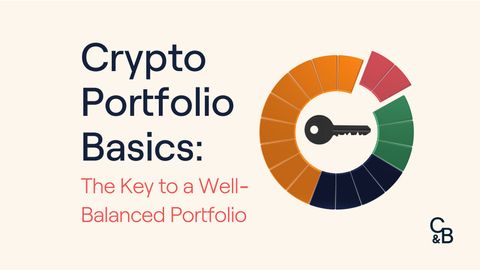Key Points
- A concentrated crypto portfolio only has 1 or a few assets, bringing with it increased risks but also greater potential for higher returns.
- A diverse crypto portfolio distributes risk across multiple crypto assets and is potentially less influenced by market volatility.
- A well-balanced crypto portfolio includes assets across different market sectors, with varying market caps, and various use cases.
Bitcoin and Ethereum are all you need, right? It depends.
While some investors prefer to buy and hold the largest cryptocurrencies, others may turn to altcoins or stablecoins.
But which strategy is best?
While there isn't a single portfolio that suits every investor, if you want to maximise your return while minimising your risk, a good starting point is a diversified and well-balanced crypto portfolio.
Don't know where to start? Read on as we break down how to build a well-balanced crypto portfolio.
What is a Crypto Portfolio?
A crypto investment portfolio is a basket of cryptocurrencies.
It's pretty similar to a traditional investment portfolio, except you’re sticking to one asset class (cryptocurrency) rather than a combination of stocks, real estate and bonds.
Crypto Portfolio Building Basics
The primary goal of building a well-balanced portfolio is to minimise the impact of the - at times - volatile market by managing risk through diversification.
Creating a well-balanced crypto portfolio by diversifying the assets you invest in can significantly reduce your exposure to risk while increasing exposure to a broader range of digital assets.
There is no one-size-fits-all approach to building a portfolio and each strategy comes with different trade-offs for different types of traders or investors depending on their risk appetite and profile - essentially, your ability to accept losses in exchange for the possibility of higher returns.
Concentrated vs Diversified Crypto Portfolios
There are two main strategies for constructing a crypto portfolio: building a concentrated portfolio or a highly diversified portfolio. Each approach comes with trade-offs that you should consider.
Concentrated
A concentrated portfolio holds only a few assets.
Holding a select number of assets can generate higher returns if those assets prove to perform strongly over periods of time. However, picking winning assets is no easy feat and requires much more skill. The probability of picking high performers reduces with the lower number of assets you have exposure to. Moreover, with a potential for high reward comes an equal potential for high risk.
Concentrated portfolios are much more susceptible to volatility and carry considerable risk as every little change in market sentiment can have ripple effects on your portfolio. They also create a concentration of risk and potential failure if an investor is allocated to only one or a few assets in in similar sectors of the crypto market. Overexposure to a single protocol and the assets that live in that ecosystem can put investors at risk if something goes wrong, like in the case of the Terra LUNA fiasco.
Diversified
A diverse portfolio holds various crypto assets, usually across multiple sectors or protocols. Holding a variety of assets helps the investor mitigate market risk since all their eggs aren’t concentrated in one basket. The structure of these portfolios also tends to be fortified against market volatility. If the price of one asset drops significantly, the assets unaffected by the price drop can help offset or minimise any losses.
Diversified portfolios distribute volatility and risk laterally, as they mirror trends across the market. As a result, the performance of this portfolio may not be as significant as some more concentrated versions, however, this safeguards against extreme negative price performance and risk.
For beginner investors, diversified portfolios tend to give greater balance and less volatility compared to concentrated portfolios.
How to Build a well balanced portfolio
The following points can help you formulate your own decisions when building out your portfolio.
Of course, Caleb & Brown’s brokers and the research they have access to courtesy of in-house analysts can help inform your portfolio construction, too.
Diversify Risk (To a Point)
Diversification is great for balancing your portfolio. But over-diversification can lead to a portfolio that essentially mirrors the market. Gains and losses can continually cancel each other out, so it’s important to diversify to a point.
These three tips can help you diversify your portfolio;
Invest in assets with different risk profiles: Distribute your investments across large, medium, and small-cap crypto assets and give them appropriate weightings. Generally, the lower the market cap, the higher the risk. Your risk profile will determine what's best for you, but consider striking a balance between each category.
Check crypto asset market caps at CoinGecko or CoinMarketCap.
Pick the right number of assets: While there is no magic number that tips the scales of diversification, if you’re unable to stay up to date with important movements, updates and news for each of your assets, then you might have one too many in your portfolio.
Allocate across different types of assets: Selecting assets with varying use cases across different crypto sectors or protocols is another effective way for investors to negate risk. If something happens in one industry that adversely affects the value of your investments, having crypto assets tied to another industry could help you maintain your position until the downward trend subsides.
Include Stablecoins
Allocating a portion of your portfolio to Stablecoins can help provide liquidity for your portfolio. Having stablecoins sitting on the sidelines can provide you with the ammunition to quickly and easily take advantage of market opportunities as they arise.
One of the many benefits of trading with Caleb & Brown is the available unlimited pairings, which save you time and avoid the fees of trading through multiple pairs to get the trade outcome you want.
Rebalance Your Portfolio (If Needed)
Portfolio rebalancing is the process of adjusting your asset allocation to match your original risk and reward profile. Doing so enables investors to rebalance risk by buying into (or selling out of) different assets. Rebalancing can take place at any time, but it is common for investors to do so as market conditions change.
During a bull market - a period of time where the majority of investors are buying and asset prices are rising - some investors may opt for a more aggressive approach with a stronger allocation of high-risk, high-reward assets.
Conversely, during a bear market - a period of decline where market sentiment is overwhelmingly negative - other investors may favour a more defensive portfolio, allocated to blue-chip crypto assets or stablecoins with lower risk and reward profiles.
It’s worth thinking twice over rebalancing, as swapping between assets will incur fees that will eat into your returns.
Do Your Own Research
Whether you’re placing your first investment or building out an entire portfolio, it all starts with one thing: research. Opinions may motivate us to buy or sell, but facts and research can objectively guide you towards making effective and informed investment decisions.
Never Invest More Than You Can Afford to Lose
There's one golden investment rule across both crypto and the traditional stock market — never invest more than you can afford to lose.
Your portfolio isn't correctly balanced if it keeps you up at night. Your positions should not cause you serious financial consequences if something were to go wrong.
Diversify a Portfolio with These Types of Assets
Bitcoin is the most famous cryptocurrency and is the biggest by market cap. But a well-balanced portfolio will include a selection of different coins to reduce overall risk. Below are the most common types of crypto within the market. While most coins fall under one type, some coins have multiple uses, such as Ether (ETH).
Payment Currencies
Payment currencies, like Bitcoin (BTC), can be thought of as digital money living on a decentralised network. Their features are usually built to exceed—or be an alternative to—traditional money. Other payment currencies focus on disrupting payment methods within a particular industry.
Stablecoins
Stablecoins, like Tether (USDT) and USD Coin (USDC), attempt to offer relative price stability. Their market value is usually pegged to the value of a stable asset, like USD, the euro or gold. Unlike other crypto assets, where prices can fluctuate wildly, stablecoins are designed to maintain a stable value over time.
Utility Tokens
As the name implies, utility tokens are created to serve a particular purpose (or multiple purposes) on a specific platform. In essence, they allow users to interact with features or applications unique to a specific platform. Sometimes, utility tokens are used to pay for products or services on a network (like Binance’s BNB token). Other times, they can function as the means through which a user can unlock a network’s utility (like XRP for making quick, liquid, global money transfers).
Infrastructure Tokens
Infrastructure tokens such as Ethereum (ETH) and Cardano (ADA) are cryptocurrencies that are used to front the cost of running a network. These tokens are paid by a user to the nodes responsible for maintaining the network. In return, users can use the network to access applications and services or to create their own applications within the network.
Meme Coins
Meme coins, like the dog-themed Dogecoin (DOGE), are cryptocurrencies inspired by the social currency of the internet: memes. Meme coins typically have a massive or unlimited supply, which accounts for their unusually low per-unit price.
Governance Tokens
Governance Tokens, like Uniswap (UNI) and Aave (AAVE), as the name implies, provide holders the right to vote (or govern) on issues that guide the development of a blockchain project.
This allows projects to distribute the decision-making power to their community of token holders.
Common Crypto Investing Strategies
There’s more to balancing your portfolio than simply holding multiple assets. Following an effective strategy will go a long way in creating a suitable portfolio for your risk tolerance.
HODL
Short for ‘hold on for dear life’, this strategy involves buying crypto and holding on to it for the long term—regardless of volatility—with the expectation of high returns in the future. The popular term is derived from a misspelling of the word “hold”.
Dollar Cost Averaging (DCA)
Dollar cost averaging (DCA) is a strategy investors use to minimise the impact of volatility without investing additional effort into timing the market. Using this method, investors invest predetermined amounts of money into a crypto asset at regular intervals. This strategy is ideal for investors interested in a more passive, set it and forget it style of investing.
Buying the Dip
Buying the dip is a common strategy that investors use to capitalise on these downward trends. It involves an investor simply purchasing a coin when prices drop. The goal is to acquire more crypto at this low price, under the assumption that the investor can profit if/when the price rises.
Recommended Reading: Common Crypto Investing Strategies Every Investor Should Know
FAQs
How many types of crypto assets should I have in my portfolio?
As many as you’d like to invest in. Keep in mind though that the more you invest, the more you risk over-diversifying your portfolio. Finding time to carry out ongoing research becomes increasingly more difficult with every coin you add to your portfolio.
Should I purchase a portfolio tracker?
Portfolio trackers could be helpful for investors who desire a more user-friendly view of what’s currently in their wallet. At Caleb & Brown, you won’t need one. Within your dashboard, you have a complete view of your holdings and transaction history.
Can over-diversification harm the growth of my portfolio?
Over-diversification won’t harm the growth of your portfolio per se. If the market rises in value, your portfolio will probably mirror this. An over-diversified portfolio reduces risk so much that an investor will most likely be unable to capitalise on volatile positive price action that occurs in crypto markets.
Start Building Your Crypto Portfolio With Caleb & Brown
You don’t have to be an expert to build a well-balanced crypto portfolio.
Caleb & Brown is the world's leading crypto brokerage for beginner and advanced investors alike, with 100s of liquid assets readily available for your portfolio.
Our personalised broker service makes crypto investing simple. A dedicated member of our broker team is always on hand to guide you along the way, giving you the confidence you need to navigate the world of crypto. Not to mention key features such as:
- No joining or signup costs
- Industry-leading storage solutions
- 24/7 customer support
If you are ready to take the next step and invest, contact your crypto broker today.
Not yet a client? Sign up for your free consultation.
Disclaimer: This assessment does not consider your personal circumstances, and should not be construed as financial, legal or investment advice. These thoughts are ours only and should only be taken as educational by the reader. Under no circumstances do we make recommendation or assurance towards the views expressed in the blog-post. The Company disclaims all duties and liabilities, including liability for negligence, for any loss or damage which is suffered or incurred by any person acting on any information provided.






